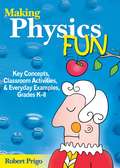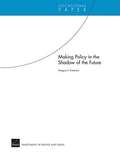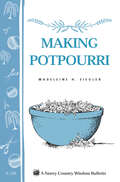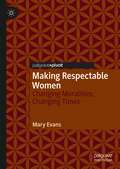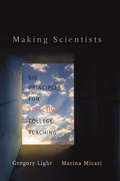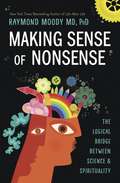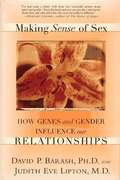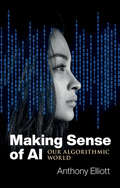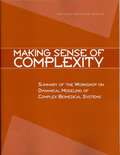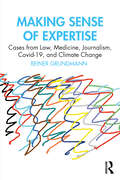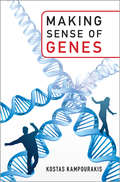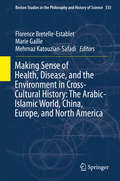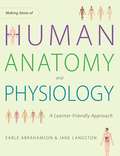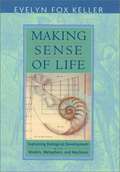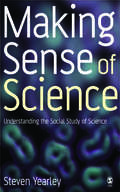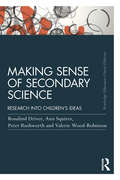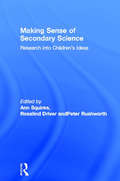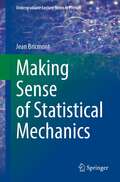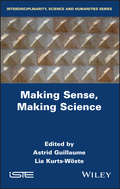- Table View
- List View
Making Physics Fun
by Robert PrigoBoost student interest and understanding in the physical sciences!Teaching physical science in the elementary and middle grades can be challenging for busy teachers faced with growing demands and limited resources. Robert Prigo provides fun and engaging activities using safe, available materials that educators can easily incorporate into lesson plans. Extensive examples, sample inquiry questions, and ideas for initiating units are readily available for teachers to pick and choose from to meet student needs.The result of more than two decades of professional development work with hundreds of teachers and administrators, this resource addresses specific areas of physical science, including motion and force, waves and sound, light and electromagnetic waves, and more. Dozens of activities demonstrating physics in action help students of all ages relate physics principles to their everyday experiences.This practitioner-friendly resource helps teachers: Address the "big ideas" in K-8 science education Promote student understanding with ready-to-use learning experiences Use hands-on activities to help students make larger, real-world connections Assemble classroom learning centers to facilitate deeper understanding of basic physics principlesWith conceptual summaries to support teachers' proficiency and understanding of the content, this guidebook is ideal for bringing physics to life for students in the classroom and in their lives!
Making Physics Fun: Key Concepts, Classroom Activities, and Everyday Examples, Grades K-8
by Robert PrigoIn easy-to-understand language, this resource presents engaging, ready-to-use learning experiences that address the "big ideas" in K–8 science education and help students make larger, real-world connections.
Making Policy in the Shadow of the Future
by Gregory F. TrevertonThe National Intelligence Council's 2008 report "Global Trends 2025: A Transformed World" projects what the world will look like in 2025 based on recent trends. This paper asks: How should U.S. policy adapt now to account for these trends and the future that will result from them? The author explores such issues as climate change, defense, international relations, and the structure of the federal government.
Making Potpourri: Storey's Country Wisdom Bulletin A-130 (Storey Country Wisdom Bulletin Ser.)
by Madeleine H. SieglerSince 1973, Storey's Country Wisdom Bulletins have offered practical, hands-on instructions designed to help readers master dozens of country living skills quickly and easily. There are now more than 170 titles in this series, and their remarkable popularity reflects the common desire of country and city dwellers alike to cultivate personal independence in everyday life.
Making Progress in Primary Science: A Study Book for Teachers and Student Teachers
by Wynne Harlen Christine Macro Kathleen Reed Mike SchillingThis new and extensively revised edition of Progress in Primary Science is intended for all those involved in training teachers of primary school science, both preservice and on INSET courses. Its flexible modular structure enables course leaders to tailor their course to participants' needs. Each module can be studied individually or as part of an extended programme and contains notes for facilitators, photocopiable workshop materials, activities for practitioners and suggestions for further reading. Throughout the book the focus is on the learning of science as an investigative process through which pupils develop an understanding of ideas. This is supported by modules on different aspects of teaching and learning in science, including: building on children's own ideas how to ask and answer questions managing practical work in the classroom science for very young children effective assessment, self-assessment and feedback cross-curricular links ICT and science science outside the classroom. The companion study book currently available can be used by those participating on these courses. It follows the same modular structure and contains the same information as this book, and makes planning and delivering the course easier and less time consuming for the course leader.
Making Respectable Women: Changing Moralities, Changing Times
by Mary EvansThis book studies the ways in which the assessment of being or not being ‘respectable’ has been applied to women in the UK in the past one hundred and fifty years. Mary Evans shows how the term ‘respectable’ has changed and how, most importantly, the basis of the ways in which the respectability of women has been judged has shifted from a location in women’s personal, domestic and sexual behaviour to that of how women engage in contemporary forms of citizenship, not the least of which is paid work. This shift has important social and political implications that have seldom been explored: amongst these are the growing marginalisation of the validation of the traditional care work of women, the assumption that paid work is implicitly and inevitably empowering and the complex ways in which respectability and conformity to highly sexualised conventions about female appearance have been normalised. Making Respectable Women makes use of archive material to show how the changing definition of a moral and social concept can have an impact on both the behaviour and the choices of individuals and the operations of institutional power. It will be of interest to students and scholars across the humanities and social sciences.
Making Scientists
by Gregory Light Marina MicariGregory Light and Marina Micari reject the view that science, technology, engineering, and mathematics are elite disciplines restricted to a small number with innate talent. Rich in concrete advice, Making Scientists offers a new paradigm of how scientific subjects can be taught at the college level to underrepresented groups.
Making Sense Of Nonsense: The Logical Bridge Between Science And Spirituality
by Raymond MoodyWhat do the whimsical writings of Dr. Seuss have in common with near-death experiences? The answer is that nonsense writing and spiritual experiences seem to defy all logic and yet they both can make a powerful personal impact. In this book, New York Times bestselling author Dr. Raymond Moody shares the groundbreaking results of five decades of research into the philosophy of nonsense, revealing dynamic new perspectives on language, logic, and the mystical side of life. Explore the meaningful feelings that accompany nonsense language and learn how engaging with nonsense can help you on your own spiritual path. Discover how nonsense transcends classical logic, opening the doorway to new spiritual and philosophical breakthroughs. With dozens of examples from literature, comedy, music, and the history of religion, this book presents a unique new approach to the mysteries of the human spirit.
Making Sense Of Sex: How Genes And Gender Influence Our Relationships
by David P. Barash Judith Eve LiptonWhy do most women prefer romance, and men, sex? Why do women live longer than men? Why are men willing to pay for sex while women almost never are? Why are women nearly always the primary caregivers of young children? What happens when a man's brain is trapped in a woman's body? When is a short, balding middle-aged man more attractive than a tall, handsome, young one? In Making Sense of Sex, the husband-and-wife team of David Barash, an evolutionary biologist, and Judith Lipton, a clinical psychiatrist, draw on their respective areas of expertise to explore and explain the central fact of our existence -- that men and women are fundamentally, unalterably different. They present an eye-opening and wide-ranging consideration of what those differences are, how they came to be, why they are important, and what they mean in our everyday lives. The authors integrate biological and anthropological findings with real-life stories of indviduals to address the conundrums that surround male-female behavior and relationships. Drawing on the latest research in evolutionary biology, they trace the multifaceted gender gap to the basic, defining difference between males and females: that one makes sperm, the other, eggs. They show how that distinction explains why women and men differ in essential ways, exploring such questions as: Why are men more attracted than women to pornography, group sex, and one-night stands? Why are women the "gatekeepers" of sex? Why do women have orgasms?Making Sense of Sex is a highly informative and entertaining look at human relationships. The book will help readers not only to better understand themselves, but to better understand their children, their relatives, and their lovers with whom they share so much yet find so infuriatingly and fascinatingly different.
Making Sense in Common: A Reading of Whitehead in Times of Collapse (Posthumanities)
by Isabelle StengersA leading philosopher seeks to recover &“common sense&” as a meeting place to reconcile science and philosophy With her previous books on Alfred North Whitehead, Isabelle Stengers not only secured a reputation as one of the premier philosophers of our times but also inspired a rethinking of critical theory, political thought, and radical philosophy across a range of disciplines. Here, Stengers unveils what might well be seen as her definitive reading of Whitehead.Making Sense in Common will be greeted eagerly by the growing group of scholars who use Stengers&’s work on Whitehead as a model for how to think with conceptual precision through diverse domains of inquiry: environmentalism and ecology, animal studies, media and technology studies, the history and philosophy of science, feminism, and capitalism. On the other hand, the significance of this new book extends beyond Whitehead. Instead, it lies in Stengers&’s recovery of the idea of &“common sense&” as a meeting place—a commons—where opposed ideas of science and humanistic inquiry can engage one another and help to move society forward. Her reconciliation of science and philosophy is especially urgent today—when climate disaster looms all around us, when the values of what we thought of as civilization and modernity are discredited, and when expertise of any kind is under attack.
Making Sense of AI: Our Algorithmic World
by Anthony ElliottIndustrial robots, self-driving cars, customer-service chatbots and Google’s algorithmic predictions have brought the topic of artificial intelligence into public debate. Why is AI the source of such intense controversy and what are its economic, political, social and cultural consequences? Tracing the changing fortunes of artificial intelligence, Elliott develops a systematic account of how automated intelligent machines impact different spheres and aspects of public and private life. Among the issues discussed are the automation of workforces, surveillance capitalism, warfare and lethal autonomous weapons, the spread of racist robots and the automation of social inequalities. Elliott also considers the decisive role of AI in confronting global risks and social futures, including global pandemics such as COVID-19, and how smart algorithms are impacting the search for energy security and combating climate change. Making Sense of AI provides a judiciously comprehensive account of artificial intelligence for those with little or no previous knowledge of the topic. It will be an invaluable book both for students in the social sciences and humanities and for general readers.
Making Sense of Complexity: Summary of the Workshop on Dynamical Modeling of Complex Biomedical Systems
by George CasellaSummary of the Workshop on Dynamical Modeling of Complex Biomedical Systems
Making Sense of Expertise: Cases from Law, Medicine, Journalism, Covid-19, and Climate Change
by Reiner GrundmannCurrent debates about experts are often polarized and based on mistaken assumptions, with expertise either defended or denigrated. Making Sense of Expertise instead proposes a conceptual framework for the study of expertise in order to facilitate a more nuanced understanding of the role of expertise in contemporary society. Too often different meanings of experts and expertise are implied without making them explicit. Grundmann’s approach to expertise is based on a synthesis of approaches that exist in various fields of knowledge. The book aims at dispelling much of the confusion by offering a comprehensive and rigorous framework for the study of expertise. A series of in-depth case studies drawn from contemporary issues, including the climate crisis and the COVID-19 pandemic, provide the empirical basis of the author’s comprehensive approach. This thought-provoking book will be of great interests to students, instructors and researchers in a range of fields in the humanities, social sciences, and science and technology studies.
Making Sense of Genes
by Kostas KampourakisWhat are genes? What do genes do? These seemingly simple questions are in fact challenging to answer accurately. As a result, there are widespread misunderstandings and over-simplistic answers, which lead to common conceptions widely portrayed in the media, such as the existence of a gene 'for' a particular characteristic or disease. In reality, the DNA we inherit interacts continuously with the environment and functions differently as we age. What our parents hand down to us is just the beginning of our life story. This comprehensive book analyses and explains the gene concept, combining philosophical, historical, psychological and educational perspectives with current research in genetics and genomics. It summarises what we currently know and do not know about genes and the potential impact of genetics on all our lives. Making Sense of Genes is an accessible but rigorous introduction to contemporary genetics concepts for non-experts, undergraduate students, teachers and healthcare professionals.
Making Sense of Health, Disease, and the Environment in Cross-Cultural History: The Arabic-Islamic World, China, Europe, and North America (Boston Studies in the Philosophy and History of Science #333)
by Florence Bretelle-Establet Mehrnaz Katouzian-Safadi Marie GailleThis book has been defined around three important issues: the first sheds light on how people, in various philosophical, religious, and political contexts, understand the natural environment, and how the relationship between the environment and the body is perceived; the second focuses on the perceptions that a particular natural environment is good or bad for human health and examines the reasons behind such characterizations ; the third examines the promotion, in history, of specific practices to take advantage of the health benefits, or avoid the harm, caused by certain environments and also efforts made to change environments supposed to be harmful to human health. The feeling and/or the observation that the natural environment can have effects on human health have been, and are still commonly shared throughout the world. This led us to raise the issue of the links observed and believed to exist between human beings and the natural environment in a broad chronological and geographical framework. In this investigation, we bring the reader from ancient and late imperial China to the medieval Arab world up to medieval, modern, and contemporary Europe. This book does not examine these relationships through the prism of the knowledge of our modern contemporary European experience, which, still too often, leads to the feeling of totally different worlds. Rather, it questions protagonists who, in different times and in different places, have reflected, on their own terms, on the links between environment and health and tries to obtain a better understanding of why these links took the form they did in these precise contexts. This book targets an academic readership as well as an “informed audience”, for whom present issues of environment and health can be nourished by the reflections of the past.
Making Sense of Human Anatomy and Physiology: A Learner-Friendly Approach
by Earle Abrahamson Jane LangstonDesigned to be user-friendly and informative for both students and teachers, this book provides a road map for understanding problems and issues that arise in the study of anatomy and physiology. Students will find tips to develop specific study skills that lead to maximum understanding and retention. They will learn strategies not only for passing an examination or assessment, but also for permanently retaining the fundamental building blocks of anatomical study and application. For the teacher and educator, the book provides useful insight into practical and effective assessment techniques, explores the subject matter from a learning approach perspective, and considers different methods of teaching to best to convey the message and meaning of anatomy and physiology. Supported by clear diagrams and illustrations, this is a key text for teachers who want a useful toolbox of creative techniques and ideas that will enhance the learning experience. In addition to the wealth of information it provides, Making Sense of Human Anatomy and Physiology sets in place a bedrock of learning skills for future study, regardless of the subject. Students of beauty therapies, holistic and complementary therapies, and fitness professionals--yoga teachers, personal trainers, sports coaches, and dance teachers--will gain not only a basic understanding of anatomy and physiology, but also the skills to learn such a subject. Allied professionals in nursing, biomedical science, dentistry, occupational therapy, physiotherapy, midwifery, zoology, biology and veterinary science will also find this book an invaluable resource. The final chapters offer suggestions for the further exploration of concepts, assessment, learning activities, and applications.
Making Sense of Life: Explaining Biological Development with Models, Metaphors, and Machines
by Evelyn Fox KellerA history of the diverse and changing nature of biological explanation in a particularly charged field, "Making Sense of Life" draws readers attention to the temporal, disciplinary, and cultural components of what biologists mean, and what they understand, when they propose to explain life. Illustrations. Copyright © Libri GmbH. All rights reserved.
Making Sense of Quantum Mechanics
by Jean BricmontThis book explains, in simple terms, with a minimum of mathematics, why things can appear to be in two places at the same time, why correlations between simultaneous events occurring far apart cannot be explained by local mechanisms, and why, nevertheless, the quantum theory can be understood in terms of matter in motion. No need to worry, as some people do, whether a cat can be both dead and alive, whether the moon is there when nobody looks at it, or whether quantum systems need an observer to acquire definite properties. The author's inimitable and even humorous style makes the book a pleasure to read while bringing a new clarity to many of the longstanding puzzles of quantum physics.
Making Sense of Science: Separating Substance from Spain
by Cornelia DeanCornelia Dean draws on her 30 years as a science journalist with the New York Times to expose the flawed reasoning and knowledge gaps that handicap readers when they try to make sense of science. She calls attention to conflicts of interest in research and the price society pays when science journalism declines and funding dries up.
Making Sense of Science: Understanding the Social Study of Science
by Steven Yearley`Fluid, readable and accessible ... I found the overall quality of the book to be excellent. It provides an overview of major (and preceding) developments in the field of science studies. It examines landmark works, authors, concepts and approaches ... I will certainly use this book as one of the course texts' Eileen Crist, Associate Professor, Science & Technology in Society, Virginia Tech Science is at the heart of contemporary society and is therefore central to the social sciences. Yet science studies has often encountered resistance from social scientists. This book attempts to remedy this by giving the most extensive, thorough and best argued account of the field and explaining to social scientists why science matters to them. This is a landmark book that demystifies science studies and successfully bridges the divide between social theory and the sociology of science. Illustrated with relevant, illuminating examples, it provides the ideal guide to science studies and social theory.
Making Sense of Secondary Science: Research into children's ideas
by Rosalind Driver Peter Rushworth Ann Squires Valerie Wood-RobinsonWhat ideas do children hold about the natural world? How do these ideas affect their learning of science? Young learners bring to the classroom knowledge and ideas about many aspects of the natural world constructed from their experiences of education and from outside school. These ideas contribute to subsequent learning, and research has shown that teaching of science is unlikely to be effective unless it takes learners’ perspectives into account. Making Sense of Secondary Science provides a concise, accessible summary of international research into learners’ ideas about science, presenting evidence-based insight into the conceptions that learners hold, before and even despite teaching. With expert summaries from across the science domains, it covers research findings from life and living processes, materials and their properties and physical processes This classic text is essential reading for all trainee secondary, elementary and primary school science teachers, as well as those researching the science curriculum and science methods, who want to deepen their understanding of how learners think and to use these insights to inform teaching strategies. It also provides a baseline for researchers wishing to investigate contemporary influences on children’s ideas and to study the persistence of these conceptions. Both components of Making Sense of Secondary Science – this book and the accompanying teacher’s resource file, Making Sense of Secondary Science: Support materials for teachers - were developed as a result of a collaborative project between Leeds City Council Department of Education and the Children’s Learning in Science Research Group at the University of Leeds, UK.
Making Sense of Secondary Science: Research into children’s ideas
by Rosalind Driver Peter Rushworth Ann Squires Valerie Wood-RobinsonWhen children begin secondary school they already have knowledge and ideas about many aspects of the natural world from their experiences both in primary classes and outside school. These ideas, right or wrong, form the basis of all they subsequently learn. Research has shown that teaching is unlikely to be effective unless it takes into account the position from which the learner starts. Making Sense of Secondary Science provides a concise and accessible summary of the research that has been done internationally in this area. The research findings are arranged in three main sections: * life and living processes* materials and their properties* physical processes. Full bibliographies in each section allow interested readers to pursue the themes further. Much of this material has hitherto been available only in limited circulation specialist journals or in unpublished research. Its publication in this convenient form will be welcomed by all researchers in science education and by practicing science teachers continuing their professional development, who want to deepen their understanding of how their children think and learn.
Making Sense of Statistical Mechanics (Undergraduate Lecture Notes in Physics)
by Jean BricmontMany people, including physicists, are confused about what the Second Law of thermodynamics really means, about how it relates to the arrow of time, and about whether it can be derived from classical mechanics. They also wonder what entropy really is: Is it all about information? But, if so, then, what is its relation to fluxes of heat?One might ask similar questions about probabilities: Do they express subjective judgments by us, humans, or do they reflect facts about the world, i.e. frequencies. And what notion of probability is used in the natural sciences, in particular statistical mechanics?This book addresses all of these questions in the clear and pedagogical style for which the author is known. Although valuable as accompaniment to an undergraduate course on statistical mechanics or thermodynamics, it is not a standard course book. Instead it addresses both the essentials and the many subtle questions that are usually brushed under the carpet in such courses. As one of the most lucid accounts of the above questions, it provides enlightening reading for all those seeking answers, including students, lecturers, researchers and philosophers of science.
Making Sense of the Secular: Critical Perspectives from Europe to Asia (Routledge Studies in Religion #24)
by Ranjan GhoshThis book offers a wide range of critical perspectives on how secularism unfolds and has been made sense of across Europe and Asia. The book evaluates secularism as it exists today – its formations and discontents within contemporary discourses of power, terror, religion and cosmopolitanism – and the focus on these two continents gives critical attention to recent political and cultural developments where secularism and multiculturalism have impinged in deeply problematical ways, raising bristling ideological debates within the functioning of modern state bureaucracies. Examining issues as controversial as the state of Islam in Europe and China’s encounters with religion, secularism, and modernization provides incisive and broader perspectives on how we negotiate secularism within the contemporary threats of terrorism and other forms of fundamentalism and state-politics. However, amidst the discussions of various versions of secularism in different countries and cultural contexts, this book also raises several other issues relevant to the antitheocratic and theocratic alike, such as: Is secularism is merely a nonreligious establishment? Is secularism a kind of cultural war? How is it related to "terror"? The book at once makes sense of secularism across cultural, religious, and national borders and puts several relevant issues on the anvil for further investigations and understanding.
Making Sense, Making Science
by Astrid Guillaume Lia Kurts-WösteThis book demonstrates the federative power of the methodology of the sciences of culture by exploiting its critical, historical, and comparative principles to address both cultural objects and disciplines that report on them. Scientific activity is rethought in its dimension of interpretative act responsible for both the human and the non-human. This book fills a gap by reconnecting in an innovative and original way the scientific, artistic and ethico-political spheres.
